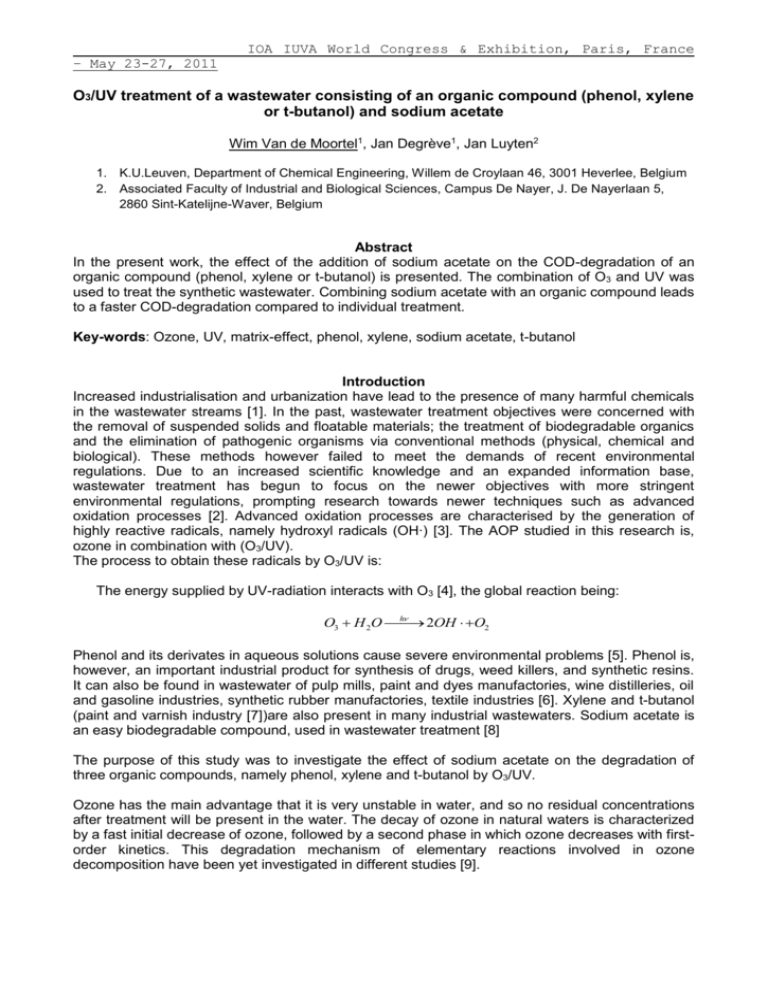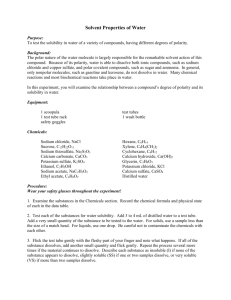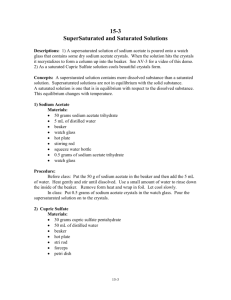View/Open - Lirias
advertisement

IOA IUVA World Congress & Exhibition, Paris, France – May 23-27, 2011 O3/UV treatment of a wastewater consisting of an organic compound (phenol, xylene or t-butanol) and sodium acetate Wim Van de Moortel1, Jan Degrève1, Jan Luyten2 1. K.U.Leuven, Department of Chemical Engineering, Willem de Croylaan 46, 3001 Heverlee, Belgium 2. Associated Faculty of Industrial and Biological Sciences, Campus De Nayer, J. De Nayerlaan 5, 2860 Sint-Katelijne-Waver, Belgium Abstract In the present work, the effect of the addition of sodium acetate on the COD-degradation of an organic compound (phenol, xylene or t-butanol) is presented. The combination of O3 and UV was used to treat the synthetic wastewater. Combining sodium acetate with an organic compound leads to a faster COD-degradation compared to individual treatment. Key-words: Ozone, UV, matrix-effect, phenol, xylene, sodium acetate, t-butanol Introduction Increased industrialisation and urbanization have lead to the presence of many harmful chemicals in the wastewater streams [1]. In the past, wastewater treatment objectives were concerned with the removal of suspended solids and floatable materials; the treatment of biodegradable organics and the elimination of pathogenic organisms via conventional methods (physical, chemical and biological). These methods however failed to meet the demands of recent environmental regulations. Due to an increased scientific knowledge and an expanded information base, wastewater treatment has begun to focus on the newer objectives with more stringent environmental regulations, prompting research towards newer techniques such as advanced oxidation processes [2]. Advanced oxidation processes are characterised by the generation of highly reactive radicals, namely hydroxyl radicals (OH∙) [3]. The AOP studied in this research is, ozone in combination with (O3/UV). The process to obtain these radicals by O3/UV is: The energy supplied by UV-radiation interacts with O3 [4], the global reaction being: h O3 H 2O 2OH O2 Phenol and its derivates in aqueous solutions cause severe environmental problems [5]. Phenol is, however, an important industrial product for synthesis of drugs, weed killers, and synthetic resins. It can also be found in wastewater of pulp mills, paint and dyes manufactories, wine distilleries, oil and gasoline industries, synthetic rubber manufactories, textile industries [6]. Xylene and t-butanol (paint and varnish industry [7])are also present in many industrial wastewaters. Sodium acetate is an easy biodegradable compound, used in wastewater treatment [8] The purpose of this study was to investigate the effect of sodium acetate on the degradation of three organic compounds, namely phenol, xylene and t-butanol by O3/UV. Ozone has the main advantage that it is very unstable in water, and so no residual concentrations after treatment will be present in the water. The decay of ozone in natural waters is characterized by a fast initial decrease of ozone, followed by a second phase in which ozone decreases with firstorder kinetics. This degradation mechanism of elementary reactions involved in ozone decomposition have been yet investigated in different studies [9]. IOA IUVA World Congress & Exhibition, Paris, France – May 23-27, 2011 Material and methods In this study, phenol, xylene, t-butanol and sodium acetate were used as model components. The phenol solution was prepared from pure standard (Acros Organics, 99 % of purity), just as the sodium acetate (VWR, Prolabo, 98 % of purity), t-butanol (Acros Organics, 99.5 % of purity) and xylene (MERCK, 98 % of purity). The experiments are performed in a labscale reactor with an internal volume of approximately 1 l, but only 900 ml was used during tests (figure 1). The labscale reactor has a Low Pressure mercury UV-lamp of 11 W. Ozone was dosed into the fluid by bubbles, with a flow of 16 gO3/h (Pacific Ozone Model SGC-21, Aqua Purification Systems, Inc.). O3-inlet UV-lamp Figure 1: Labscale reactor Measurements of COD are done by Nanocolor tubes with different indeces (CSB 160, CSB 1500). BOD was measured by BODTrack measurement device, produced by HachLange , according to the standard methods [10]. TC was analysed by Shimadzu TOC-analyser (TC 4110). Ozone may react in two distinct ways with organic compounds: i. Direct reaction of molecular ozone, and ii. Indirect reaction though the formation of hydroxyl radicals. The generation of hydroxyl readicals is promoted by higher pH values. Therefore, as pH is the predominant process variable, two different pH values will be evaluated, namely pH 3 and 9. The relative importance of direct and indirect oxidation can be evaluated by the respective reaction rate constants kOH,i and kOzone,i. Vandersmissen [11] used the DOP-concept (Dominant Oxidation Path) to express the relative importance of both pathways. A DOP-value is calculated for an organic compound (DOPOH) which incorporates both concentrations of ozone and the OH-radical and the respective rate constants both species with the organic compound: DOPOH kO3 Org [O3 ] kOH Org [OH ] With [O3] the ozone concentration in solution, [OH] the OH-radical concentration in solution and kO3-Org and kOH-Org the rate constants for respectively ozone and radical reaction. Changes in pH are made by sulphuric acid and by sodium hydroxide. The pH was not kept constant through the experiments. Results and discussion Phenol degradation In the first part of this research, phenol degradation by O 3/UV was investigated. Tests were run at two different pH’s. As said before, at lower pH, direct attack of ozone will be investigated, while a higher pH, the decomposition of ozone for the generation of hydroxyl radicals will be most IOA IUVA World Congress & Exhibition, Paris, France – May 23-27, 2011 important. Figure 2 shows the evolution of COD and TC during ozonation reactions at the two different pH’s. The trend of COD and TC are not the same, while COD-degradation at high pH is faster, TC-degradation at this pH is much slower. These tests give small proof of the mineralisation effect of direct ozone attack and the partial oxidation at high pH. (a) (b) Figure 2: The degradation of phenol by O3/UV ( a: COD , b: TC) T-butanol degradation T-butanol reacts quickly with OH-radicals and very slowly with molecular ozone [12]. Therefore, tbutanol is used to study the direct reaction kinetics of ozone with organic compounds[13]. Figure 3 shows the COD and TC degradation of t-butanol. At low pH, with predominantly direct reaction by ozone, almost no COD and TC degradation occurs. At high pH, a fast degradation is observed. (a) (b) Figure 3: The degradation of T-butanol by O3/UV (a: COD, b: TC) Xylene degradation Xylene is a chemical compound that occurs naturally in crude oil, and is used in many common products, such as paints, rubbers, adhesives, plastics and clothing [14]. It is not only toxic to the liver and the kidneys, but also hazardous for the central nervous system when it enters the body by skin contact or breathing [15]. Figure 4 (a en b) shows de COD and TC degradation of xylene in synthetic wastewater. Compared to phenol, the COD and TC of xylene degrades much faster. A possible explanation is the volatile properties of xylene. Further research is necessary. IOA IUVA World Congress & Exhibition, Paris, France – May 23-27, 2011 (a) (b) Figure 4: The degradation of xylene by O3/UV ( a: COD , b: TC) Acetate degradation Next, the degradation of (sodium) acetate in aqueous solutions was investigated using O 3 and UV. At low values for the pH (pKa(HAc) = 4.74 [16]), acetic acid will be the dominant form, while at higher pH values, acetate remains in the unprotonated form. At a pH value of 3, the main reaction is expected to be direct ozonation of acetic acid. A second test was run at a pH value of 9. Under these circumstances, indirect ozonation is expected upon the formation of reactive hydroxyl radicals. As shown in figure 4, the degradation rate of NaAc at pH 9 is much higher than at pH 3. At pH 3 no significant degradation can be observed. This can be attributed to the slow nucleofilic reaction of ozone with organic acids, as acetic acid. On the other hand, at a pH of 9, the degradation rate is much faster. After 1 hour of reaction time, 60 % is mineralised to CO2 and H2O. (a) (b) Figure 5: The degradation of sodium acetate by O3/UV (a: COD, b: TC) Water matrix effect An important issue, using advanced oxidation processes, is the interaction in a water matrix. For that reason, sodium acetate is combined with three different organic compounds, namely phenol, tbutanol and xylene. Figure 6 showes the combined degradation compared to the individual treatment at the same treatment conditions. A synergistic effect is shown, at both pH. Presumably, the formation of reaction intermediates initiates a faster degradation of the present compounds. IOA IUVA World Congress & Exhibition, Paris, France – May 23-27, 2011 (a) (b) (c) (d) (e) (f) Figure 6 : Comparison between individual treatment (♦) and combined degradation (■) for different combinations: a: t-butanol and sodium acetate at pH3; b: t-butanol and sodium acetate at pH9; c: phenol and sodium acetate at pH3; d: phenol and sodium acetate at pH9; e: xylene and sodium acetate at pH3; f: xylene and sodium acetate at pH9 IOA IUVA World Congress & Exhibition, Paris, France – May 23-27, 2011 A synergistic factor can be defined as: dCOD dt i NaAc Ri dCOD dCOD dt i dt NaAc Table 1: synergistic factor Ri for the different combinations with sodium acetate pH3 phenol t-butanol 5 min 15 min 25 min 35 min 45 min 55 min pH9 xylene phenol t-butanol 1,216814 4,55 3,1547619 1,178475 4,55 0,90096 0,875 0,89747537 1,140694 0,875 / 2,566667 0,63095238 0,962121 2,566667 1,323285 -0,15556 1,24875992 0,980141 -0,15556 2,309735 1,4 2,4537037 1,240123 1,4 5,293142 1,507692 1,10416667 0,985695 1,507692 xylene 3,154762 0,897475 0,630952 1,24876 2,453704 1,104167 Table 1 shows the synergistic factor during the treatment of the different water matrices. In most cases the factor is higher at the beginning of the treatment and lower at the end of the treatment. Especially for t-butanol and xylene, and less for the combination with phenol. Conclusions First in this study, the COD-degradation rate of four different compounds was studied at pH3 and 9. At low pH, phenol and xylene will react predominantly with molecular ozone, while sodium acetate and t-butanol degraded very slow. At high pH, all compounds degrade properly when indirect reactions with hydroxyl radical is predominant. However, the main aim of this study was to show the effect on COD-degradation by an O3/UVprocess, when sodium acetate was added to a dissolved organic compound. Different tests showed the increasing COD-degradation of the water matrix compared to individual treatment. This effect was higher in different matrices. Also the pH at the beginning of the experiment showed to be important. The synergistic effect of adding sodium acetate is higher at the start of the treatment, and degrades at the end of the treatment, especially for the combination between sodium acetate and t-butanol and xylene. Acknowledgment “Research funded by a Ph.D. grant of the Agency for Innovation by Science and Technology (IWT) References 1. Khokhawala, I.M., Gogate, P.R., Degradation of phenol using a combination of ultrasonic and UV irradiations at pilot scale operation, Ultrasonics Sonochemistry, 17, 833 – 838 (2010) 2. Gogate, P.R., Cavitation: an auxiliary technique in wastewater treatment schemes, Advances in Environmental Research, 6, 335 – 358, 2002 3. Esplugas, S., Gimenez, J., Contreras, S., Pascual, E., Rodriguez, M., Comparison of different advanced oxidation processes for phenol degradation, Water Research, 36, 1034 – 1042 (2002) 4. Beltran, F.J., Ozone Reaction Kinetics for Water and Wastewater Systems, Lewis Publishers, 2004 IOA IUVA World Congress & Exhibition, Paris, France – May 23-27, 2011 5. Chiou, C.H., Juang, R.S., Photocatalytic degradation of phenol in aqueous solutions by Prdoped TiO2 nanoparticles, Journal of Hazardous Materials, 149, 1 – 7 (2007) 6. Turhan, K., Uzman, S., Removal of phenol from water using ozone, Desalination, 229, 257 – 263 (2008) 7. Krivosheev, P.A., Komarova, L.F., Poletaeva, M.A., Lebedev, I.A., Lavrinenko, S.S., Wastewater Treatment with New Activated Charcoals To Remove Butanol, Russian Journal of Applied Chemistry, 77 (9), 1515 – 1517 (2004) 8. Choi, H.J., Lee, S.M., Choi, C.H., Kwon, M.C., Lee, H.Y., Influence of the wastewater composition on denitrification and biological p-removal in the S-DN-P-process (b) Effect of acetate, Journal of Hazardous Materials, 158, 151 – 156 (2008) 9. Hoigné, J., Bader, H., Haag, W.R., Staehelin, J., Rate constants of reactions of ozone with organic and inorganic compounds in water – III. Inorganic compounds and radicals, Water Research, 19 (8), 993 – 1004 (1985) 10. L.S. Clesceri, A.E. Greenberg, A.D. Eaton, Standard Methods for the examination of Water and Wastewater, 20th edition 1998 11. Vandersmissen, K., Advanced Oxidation Processes in Ozonated Water Systems: An Experimental and Theoretical Study, Phd for Doctor in Science, Katholieke Universiteit Leuven, Januari 2008 12. Barron, E., Deborde, M., Rabouan, S., Mazellier, P., Legube, B., Kinetic and mechanistic investigations of progestrerone reaction with ozone, Water Research, 40, 2181 – 2189 (2006) 13. Kuosa, M., Kallas, J., Influence of t-butanol on multicomponent reaction kinetics and mass transfer in p-nitrophenol ozonation at low pH, Chemical Engineering and Processing: Proces Intensification 48 (7), 1212 – 1221 (2009) 14. Elmrini, H., Bredin, N., Shareefdeen, Z., Heltz, M., Biofiltration of xylene emissions: bioreactor response to variations in the pollutant inlet concentration and gas flow rate, Chemical Engineering Journal, 100, 149 – 158 (2004) 15. Yoon, I., Park, C., Effects of gas flow rate, inlet concentration and temperature on biofiltration of volatile organic compounds in a peat-packed biofilter, Journal of Bioscience and Bioengeneering, 93, 165 – 169 (2002) 16. Y.K. Hong, W.H. Hong, Removal of acetic acid from aqueous solutions containing succinic acid and acetic acid by tri-n-octylamine, Separation and Purification Technology, 42 (2), 151-157 (2005)






